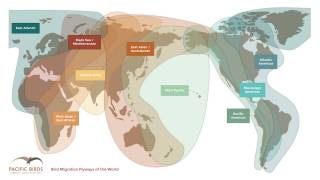The Northern Hemisphere’s Divergent Flu Season Continues

The current flu season in the USA continues to report differing trends in the temperate zone of the Northern Hemisphere during the 2019-2020 influenza season.
The World Health Organization (WHO) reported on February 3, 2020, that in North America both influenza A(H1N1)pdm09 and B viruses are co-circulating.
However, in the USA, influenza B/Victoria viruses predominant influenza detected subtype, followed by influenza A(H1N1)pdm09.
And, 37 of the 54 influenza-associated pediatric deaths were associated with influenza B viruses.
Near the USA’s southern borders, the Caribbean and Central American countries reported influenza activity was low across reporting countries, except for Mexico, which confirmed an increased activity of influenza A(H1N1)pdm09 viruses.
Just to the USA’s north, Canada reported influenza A(H1N1)pdm09 was the predominant virus, though the proportion of influenza B viruses (mainly B/Victoria lineage), continued to be higher than in previous years.
Worldwide, seasonal influenza A viruses accounted for the majority of all influenza detections.
- In Europe, influenza activity continued to increase across the region but appeared to decrease in some countries of Northern Europe.
- In Central Asia, influenza activity increased with influenza B viruses predominate.
- In Northern Africa, influenza activity appeared to decrease in Egypt after peaking in recent weeks. In tropical Africa, influenza activity was low across most reporting countries.
- In Western Asia, influenza activity remained elevated overall and continued to increase in Lebanon and Turkey.
- In East Asia, influenza-like illness (ILI) and influenza activity remained elevated overall.
- In Southern Asia, influenza activity was low in most reporting countries but increased in Afghanistan.
- In Southeast Asia, influenza activity continued to be reported in Lao People’s Democratic Republic and Malaysia and increased in Singapore.
- In the temperate zones of the Southern Hemisphere, influenza activity remained at interseasonal levels.
In response to the Influenza B ongoing impact, the US Centers for Disease Control and Prevention (CDC) issued a Health Advisory on January 13, 2020, reminding clinicians that influenza B viruses can cause severe illness in people of all ages, including children.
To reduce all influenza health issues, the CDC continues to recommend everyone 6 months of age and older get a flu shot.
The CDC says there are 4 types of influenza viruses: A, B, C, and D. Human influenza A and B viruses cause seasonal flu epidemics almost every winter in the USA.
Influenza B viruses are not divided into subtypes but instead are further classified into two lineages: B/Yamagata and B/Victoria.
All available vaccine formulations this season contain A(H3N2), A(H1N1)pdm09, and B/Victoria virus strains. The 2019-2020 U.S. quadrivalent influenza vaccines contain these and an additional influenza B/Yamagata virus.
The CDC does not recommend any specific influenza vaccine formulation over another.
International flu vaccine news published by Vax-Before-Travel.
Our Trust Standards: Medical Advisory Committee

























